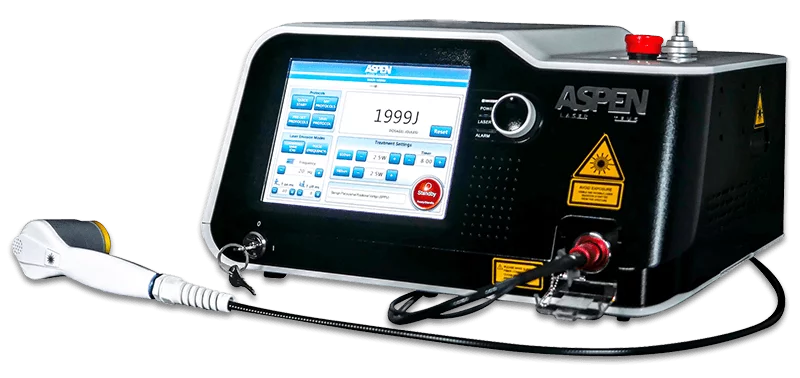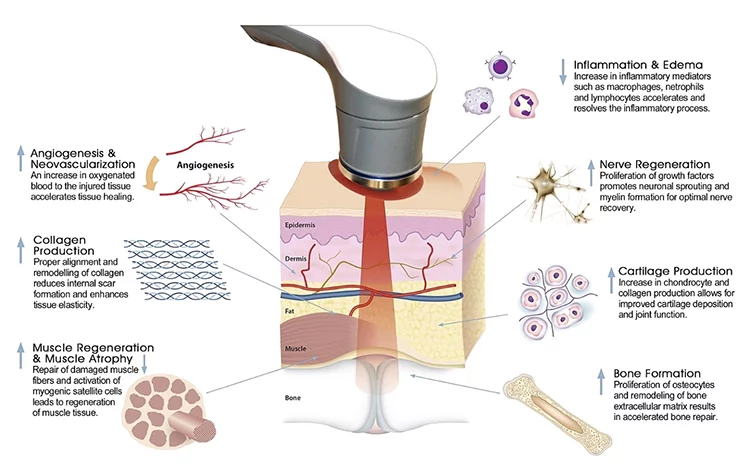Class IV Laser in Watertown SD

At Watertown Chiropractic, we use Class IV lasers that have the capacity to reach a power of 60 Watts and penetrate many centimeters below the skin's surface. Our lasers work by photobiomodulation, a process by which the laser supplies photons of energy in the form of near-infrared light, which is absorbed by chromophores in the mitochondria of the cells. The primary chromophore is cytochrome c oxidase, the terminal enzyme in the respiratory chain. Activating this enzyme increases its rate of reaction, and more adenosine triphosphate (ATP) is produced, allowing for an improved rate of healing and repair within damaged tissues. The laser light increases the energy available to the cells so that they may assimilate nutrients faster and remove waste products.
The most important and most basic effect of laser therapy is the improved production of ATP, which is the universal biological fuel within our body. When one receives laser therapy, they get a significant boost in ATP. According to Tiina Karu, Head of the Laboratory of Laser Biology and Medicine, many of the widespread benefits from laser therapy may, in fact, be related to the effects on ATP.
RESULTS IN ABOUT 3 VISITS
50% average patient-reported decrease in pain and improvement in functionality
Class IV laser therapy benefits
Class IV laser therapy has various benefits depending on how it is used, including:
Laser therapy reduces edema, swelling, and bruising because it helps with vasodilation and activates the lymphatic drainage system. Laser is also capable of reducing the inflammatory mediators TNF, interleukin-6, interleukin-1 beta, and prostaglandin E2 often found in arthritis and tendinitis.
Laser therapy has a beneficial effect on neurons that reduces pain transmitted to the brain. Laser can also stimulate the body to produce endorphins, which combat pain. Laser directed at the sympathetic ganglia leads to parasympathetic dominance in the targeted area, which can trigger blood vessel dilation and a pleasant warming sensation.
In damaged nerves, laser therapy can boost the production of proteins such as Gap-43 which speeds up the process of neuron regeneration. Laser has been demonstrated to stimulate Schwann cells and increase the thickness of the myelin sheath (the insulation that wraps around a nerve) of damaged nerves. These effects can improve overall neuron function, optimize muscle action, and restore sensation.
Photons of light from lasers penetrate deeply into the body and accelerate cellular reproduction, growth, and metabolic processes. Laser light stimulates the proliferation and health of fibroblasts (cells that produce collagen, a protein essential for wound healing). Collagen synthesis and fibril size is significantly increased. This is relevant for the healing of many types of injuries because collagen is found throughout the body, including the intervertebral disc of the spine, tendons, and ligaments.
Laser will significantly increase the formation of new capillaries, a process called angiogenesis, in damaged tissue in order to speed up the healing process. Laser is capable of significantly boosting the blood flow into the soft tissues and limb(s) treated via vasodilation. Laser therapy at sites in the neck may boost circulation and oxygenation of the brain and has been found to be helpful in certain cases of headache, vertigo, tinnitus, and balance disorders.
Live pain-free • Move better • Perform Optimally

Photochemical Action of Laser
Studies have shown that when tissue cultures are irradiated by lasers, enzymes within cells absorb energy from laser light. Visible red light and near-infrared (NIR) are absorbed within the mitochondria and the cell membrane. This produces higher ATP levels and boosts DNA production, leading to an increase in cellular health and energy.
Therefore, when applied as treatment, lasers have been shown to reduce pain and inflammation as well as stimulate nerve regeneration, muscle relaxation, and immune system response. Lasers have no effect on normal tissues because photons of light are only absorbed and utilized by the cells that need them.
